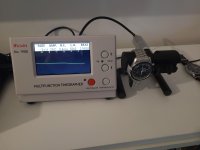@killvino summed it up.
It is pretty cool, it uses a microphone to listen to the mechanical watch and measure various things based on the timing of sounds made by the watch. The mount for the watch can be put in various positions as the results will vary in different positions (face up, face down, crown down.....).
From left to right on the display at the top:
-Rate is how many seconds per day the watch is off in the current position (measured).
-Amplitude is how far the balance swings back and forth in the current position, usually the more the better (measured).
-Beat Error basically measures if the balance swings symmetrical, again current position (same one way as the other) (measured).
-Lift Angle you have look up for the calibre and manually enter it in (it is the swing angle of the escapement) if this is entered wrong then the above may be off.
-Beat Rate is the number of beats per hour, it is figured out by the tester but can also be manually set. In the above picture (Speedmaster) 21600 beats per hour for the 861 is 6 beats per second (aka 3 Hz) which means the second hand moves six times per second and the balance is running at 3 Hz. Higher beat rate watches will have a smoother second hand swing...it is a spec of the calibre.
-The graph is just a graph of the above.
All that for $220 to my door!
Rate (seconds per day) can be adjusted inside the watch but if it is really fast or really slow it needs service. The rate can also be tuned without the tester by comparing the watch to another source but you need a good time source to compare to and have to wait much longer between adjustments (hours, maybe a day). Amplitude is the best indicator the watch needs service, if it is low it may be dirty inside, lubrication issues, magnetized or a weak mainspring.
The upside and downside is now I know how good or bad various watches are running.... As an example I now know my recently serviced SMP is running 2 s/d slower than COSC, which is
freaking me out 
/s
















